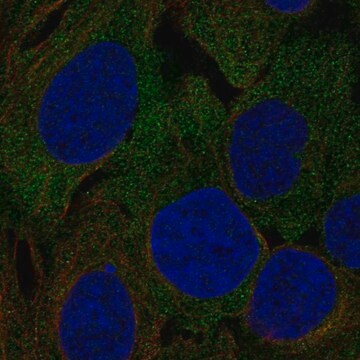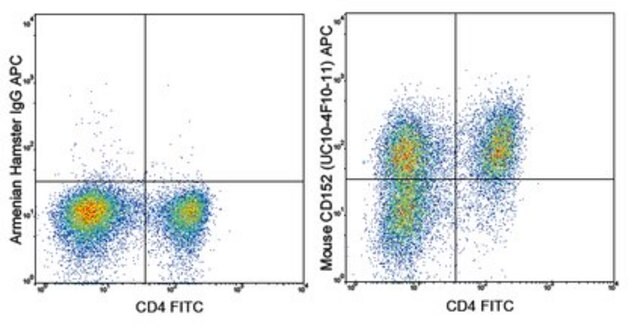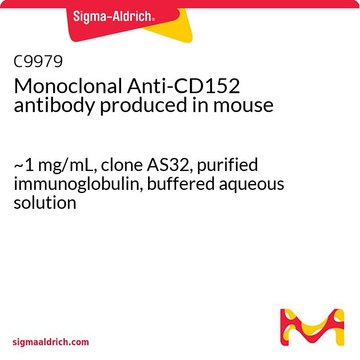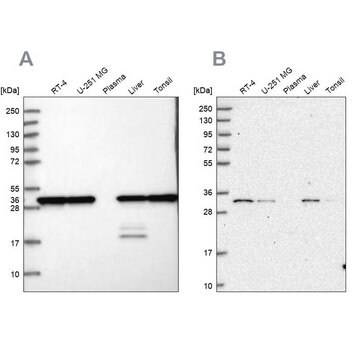04-963
Anti-CTLA4 (CD152) Antibody, clone 9H10
clone 9H10, from hamster
Sinónimos:
CD152 antigen, Cytotoxic T-lymphocyte-associated antigen 4, celiac disease 3, cytotoxic T-lymphocyte-associated protein 4, cytotoxic T-lymphocyte-associated serine esterase-4, ligand and transmembrane spliced cytotoxic T lymphocyte associated antigen 4
About This Item
Productos recomendados
origen biológico
hamster
Nivel de calidad
forma del anticuerpo
purified immunoglobulin
tipo de anticuerpo
primary antibodies
clon
9H10, monoclonal
reactividad de especies
mouse
técnicas
flow cytometry: suitable
immunoprecipitation (IP): suitable
western blot: suitable
isotipo
IgG
Nº de acceso NCBI
Nº de acceso UniProt
Condiciones de envío
wet ice
modificación del objetivo postraduccional
unmodified
Información sobre el gen
human ... CD28(940) , ICOS(29851)
Descripción general
Especificidad
Inmunógeno
Aplicación
FACS analysis of ConA (24 hours) stimulated BALB/C splenocytes for surface expression of CTLA-4 (CD152). Cells were stained with 10 ug of biotin-labeled hamster anti-CTLA-4 ,clone 9H10 (open histogram) or with PE-Sav secondary antibody alone (histogram, Figure B). Note the distinct signal difference between the control (dark control histogram) and test (clear histogram).
Immunoprecipitation: Clone 9H10 is widely used for immunoprecipitaiton of CTLA-4; recommended lysis buffers include 1% NP40; 0.5% triton X-100 with proteinase inhibitors; 1-5 µg of 9H10 is added to 300-500 µL of whole cell lysate or cell membrane protein preparations (250-500 mg/mL totall protein) and incubated 3-6 hours at 4°C, followed by capture with protein G beads following standard immunoprecipitation methods (Zhang, Y., et al., 1997).
Inflammation & Immunology
Transcription Factors
Inflammation & Autoimmune Mechanisms
Calidad
Western Blot Analysis: 1 µg/mL of a biotinylated version of this antibody detected CTLA4 in 10 µg of mouse spleen lysate.
THIS ANTIBODY IS NO BIOTINYLATED.
Descripción de destino
Forma física
Almacenamiento y estabilidad
Nota de análisis
Mouse spleen cell lysate
Otras notas
Cláusula de descargo de responsabilidad
¿No encuentra el producto adecuado?
Pruebe nuestro Herramienta de selección de productos.
Código de clase de almacenamiento
12 - Non Combustible Liquids
Clase de riesgo para el agua (WGK)
WGK 1
Punto de inflamabilidad (°F)
Not applicable
Punto de inflamabilidad (°C)
Not applicable
Certificados de análisis (COA)
Busque Certificados de análisis (COA) introduciendo el número de lote del producto. Los números de lote se encuentran en la etiqueta del producto después de las palabras «Lot» o «Batch»
¿Ya tiene este producto?
Encuentre la documentación para los productos que ha comprado recientemente en la Biblioteca de documentos.
Nuestro equipo de científicos tiene experiencia en todas las áreas de investigación: Ciencias de la vida, Ciencia de los materiales, Síntesis química, Cromatografía, Analítica y muchas otras.
Póngase en contacto con el Servicio técnico







